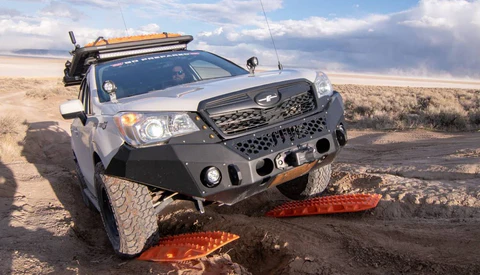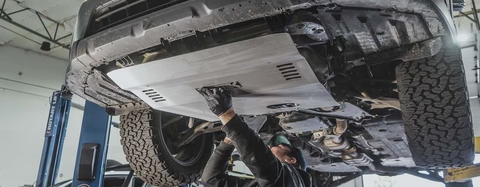Below is what Eric has for recovery gear; his kit is fairly extensive with a shovel, gloves, recovery strap, recovery rope, tree trunk protector strap, soft shackle, d-ring shackles, snatch block, winch line damper and a set of 4 recovery boards. Follow along as I showcase each product and find out what he uses it for and the pros and cons.
[caption id="attachment_335" align="aligncenter" width="604"]
 Eric's full recovery kit consisting of a shovel, recovery rope, recovery strap, tree trunk protector strap, soft shackle, steel shackles, snatch block, winch line damper, winch gloves and recovery boards[/caption]
Eric's full recovery kit consisting of a shovel, recovery rope, recovery strap, tree trunk protector strap, soft shackle, steel shackles, snatch block, winch line damper, winch gloves and recovery boards[/caption]Shovel
One of the most universal and most versatile tools you can have in your Subaru is a shovel. You can dig yourself out, use it as a lever to move rocks or logs around and in some places, it is required to have one during certain times of the year. Here in Oregon, we are required to have at least a 27” shovel during fire season and the fold up shovels do not always meet that requirement. Eric keeps a full size shovel on his roof rack just in case he ever needs it.
Recovery Boards
Eric carries a set of 4 recovery boards in his Forester, he recommends carrying 4 of them in your Subaru because of how the center differential acts. Recovery boards have many uses; you can use them to get out of a situation that you are stuck by putting them under each tire, you can use them as ramps to help get up and over an obstacle or to bridge a gap that is too large for your tire, they can be used as shovels in loose terrain, increase your Subaru’s flotation in sand or snow and can even help level your car out in camp if you have a roof top tent. Recovery boards are available with either plastic teeth or metal teeth and while the metal teeth are more durable, they come at a higher price and also a higher weight. You should refrain from spinning on them if you get either the plastic teeth or metal teeth versions. Eric chose to get the orange boards to ensure that he will have a better chance of finding them after using them.
[caption id="attachment_337" align="aligncenter" width="604"]
 Eric recommends 4 recovery boards to help get your Subaru unstuck[/caption]
Eric recommends 4 recovery boards to help get your Subaru unstuck[/caption]Gloves
Gloves are an essential item to any recovery kit, especially if you find yourself having to winch out of a situation. Gloves will protect your hands while you are winching and are highly recommended with both wire rope and synthetic rope winches. Synthetic rope can pick up debris and cut your hands while you are spooling the rope on your winch or pulling it off the drum for use. Eric highly recommends having a good set of thick gloves in your recovery kit.
[caption id="attachment_343" align="aligncenter" width="604"]
 A good set of winching gloves like these from WARN are a necessity if you plan to do any winching at all[/caption]
A good set of winching gloves like these from WARN are a necessity if you plan to do any winching at all[/caption]Recovery Strap
If you find yourself stuck, one recovery method is to use a recovery strap, not a tow strap. Recovery straps have kinetic properties and are designed to remove the energy from the vehicles and store it in the strap. Tow straps are a static strap and are not designed to handle the forces that a recovery strap can handle. Tow straps also do not remove energy from the vehicles so they are very harsh if used in a recovery setting. One downfall to the recovery strap is that you do need multiple vehicles to use it but you should always go off road with at least one other vehicle. Eric’s is 30 feet long and has a breaking strength of 14,400 pounds; Eric says the length and capacity have worked well for him when he has needed to use it.
[caption id="attachment_339" align="aligncenter" width="604"]
 Recovery straps are a great tool to have for a quick recovery[/caption]
Recovery straps are a great tool to have for a quick recovery[/caption]Recovery Rope
Eric also keeps a recovery rope in his gear as well. He prefers the recovery rope over the recovery strap as he says that it removes the energy from the car better than his strap does. The length, capacity and weight of his recovery rope is equal to the strap but it is harder to package because it is larger when it is bundled up. His recovery rope is 30 feet long and has a breaking strength of 29,300 pounds.
[caption id="attachment_338" align="aligncenter" width="604"]
 Like the recovery strap, a recovery rope is a great addition to any recovery gear kit[/caption]
Like the recovery strap, a recovery rope is a great addition to any recovery gear kit[/caption]Tree Trunk Protector Strap
Another essential item that you need in your recovery gear if you also have a winch is a good tree trunk protector. Tree trunk protector is used if you need to winch yourself out and allows you to safely anchor to a tree or rock. Not using a tree trunk protector when anchoring to a tree can damage your winch line and can also damage or kill the tree, the tree trunk protector will keep that damage from happening to the tree and your winch line. Eric has also said that the length has been adequate to go around the trees that he has needed to anchor to.
[caption id="attachment_342" align="aligncenter" width="604"]
 A tree trunk protector is a must if you every find yourself needing to anchor to a tree while winching[/caption]
A tree trunk protector is a must if you every find yourself needing to anchor to a tree while winching[/caption]Shackles
Eric carries both a soft shackle and 2 steel d-ring shackles in his recovery gear bag and uses them while he is rigging a recovery. They allow him to connect his straps to other vehicles, his winch line to his tree trunk protector or other stationary objects. Pros to the soft shackle are that it is light, it’s easy to store, it’s more moldable and versatile on recovery points, allows him to hook straps together and it will also float on water or other loose terrain like sand or snow. Its weight and versatility do come at a cost though and that is that is susceptible to abrasion since it is made out of rope. It is recommended to have an abrasion sleeve or a protective layer if you are using it around sharp corners to keep the rope from fraying.
[caption id="attachment_340" align="aligncenter" width="604"]
 Soft shackles are new players to the market but are gaining popularity for their versatility over traditional shackles. Both are must haves in your recovery kit.[/caption]
Soft shackles are new players to the market but are gaining popularity for their versatility over traditional shackles. Both are must haves in your recovery kit.[/caption]Eric’s steel shackles are very durable, strong and do not abrade like the soft shackle does. Like the soft shackle, the strength does come at a cost as it is heavier than his soft shackle, does not float on water or loose terrain and, if used improperly, can become a projectile in the event that one of your recovery straps or winch line breaks. You do NOT want to use this to connect 2 straps together because it will become a projectile should one of the straps break.
Snatch Block
Eric also keeps a snatch block handy in his recovery gear. Snatch blocks are a versatile tool to use while winching; a snatch block is a pulley that can be used to increase the pulling power of your winch, change the direction or angle of a pull and can also be used to get more winch line off of the drum of your winch. If your winch is stalling out or struggling to pull your Subaru out of a situation, then you can get your snatch block out, rig it at your anchor point and run the winch line back to your car. This will effectively double your pulling power while also getting more line off of your drum to get the winch closer to its rated capacity. Should you need to change the direction of your winch line to either get the stuck vehicle to come out at a better angle or to get your winch line to spool onto the drum straighter, you can add a snatch block to your rigging to achieve that result. A snatch block is one of my most used and favorite pieces of equipment in my own recovery kit as well.
[caption id="attachment_341" align="aligncenter" width="485"]
 The snatch block is one of the most versatile pieces in each recovery kit[/caption]
The snatch block is one of the most versatile pieces in each recovery kit[/caption]Winch Line Damper
The last item that Eric keeps in his recovery gear is a winch line damper. This goes over the winch line for safety and is designed to add weight to the line to help it fall to the ground and also act as a parachute to slow the line down should it break. If you have wire rope then you will want to position the damper towards the middle of the winch line and if you have synthetic then you will want to put it at the hook. These are the best locations to help slow the line down if it were to break. The damper that he uses has pockets on the inside if additional weight is required and also has Velcro straps to ensure that it will not fall off of the winch line. If you do any winching, be sure to add one of these to your arsenal for that added safety factor.
[caption id="attachment_344" align="aligncenter" width="604"]
 The winch line damper is a key component to winching[/caption]
The winch line damper is a key component to winching[/caption]





Comments (0)
There are no comments for this article. Be the first one to leave a message!